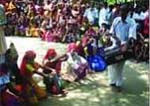 Most communities in rural Bangladesh celebrate Chaitra Sankranti and Pahela Baishakh following the age-old traditions. The celebrations bring together people, irrespective of their creed and social differences.
Most communities in rural Bangladesh celebrate Chaitra Sankranti and Pahela Baishakh following the age-old traditions. The celebrations bring together people, irrespective of their creed and social differences.
Usually rural people arrange weeklong programmes to celebrate the end of a year and the beginning of another. The preparations start a month before Chaitra Sankranti and Pahela Baishakh. An interesting aspect of these festivals is that Chaitra Sankranti has more colour than Pahela Baishakh.
The festivities begin with ‘Gajoner Mela’ and ‘Charok’ — two major elements of Chaitra Sankranti celebration. Among Bengalis and other ethnic minorities (also known as indigenous people) the nature of the celebrations may vary, but the spirit is the same: well wishes, merriment and festivity.
Events usually included in such festivals can be categorised in three groups: ritual based performances, customs and traditions, and entertainment.
Various ritualistic performances reflecting the age-old belief of rural people are important aspects of the Chaitra Sankranti festivity. In the rural areas, the Hindus perform several ritualistic art forms such as Kanta Bhanga-Hajrapita, Ashtogaan and Gourakkho Puja throughout the Bengali month of Chaitra, particularly on Chaitra Shankranti.
On the eve of Chaitra Sankranti, Sanyasis demonstrate their ability to endure extreme pain and discomfort by piercing their bodies with sharp objects.
Sanyasis of the Baishna Kapali Sampraday (a Hindu cult) believe that the ritualistic Hajrapita-Kanta Bhanga on the Chaitra Sankranti eve has the effect of exorcism— believing that it would free them of evil in the coming year.
With painted bodies, and wearing long hair and carrying tridents and other sharp objects, they give a horrifying and hypnotic performance by climbing on top of khejur trees and smashing thorns with their bare toes.
Ashtogaan is another kind of ritualistic kirtan-based performance practised throughout the month of Chaitra by the Hindu communities in the rural areas of southwestern Bangladesh. Ashtogaan highlights the essence of divine love for humanity through narrating the myths of the four great epochs in Hinduism: Satya Jug, Treta Jug, Dwapar Jug and Koli Jug. Leela (feats celebrating divinity) of Lakshmi-Narayan, Ram-Sita, Radha-Krishna and Gaor-Nitai are performed as representations of the four ages.
The artistes involved in these performances narrate Leelas with painted faces outside houses. During the narration, artistes enact the roles of Narayan, Ram, Krishna Lakshmi, Sita, Radha and other divine beings. The tune is similar to that of kirtan. Typical instruments like harmonium, dholok, kartal and bansi are used. The choir presents a part of the performance at one house and then moves to another house – a practice which can be likened to travelling theatre.
Another type of ritualistic performance is Gourakkho Puja which is usually performed at the cowsheds on the Pahela Baishakh eve by ringing bells and chanting for the well being of the cattle owned by both Hindus and Muslims in the South-West part of the country. The tune of performance is also similar to traditional kirtan.
Such celebration of the Chaitra Sangkranti and Pahela Baishakh, one after the other, creates opportunities for the artisans to sell handicrafts at the ‘Chaitra Sankranti Mela’. The mela is the most colourful event on Chaitra Shankranti and Pahela Baishakh. People from all communities participate in the festivities.
Though this type of mela is popularly known as Baishakhi mela in the urban areas, in the villages these fairs begin on Chaitra Shankranti eve and continue for a week. They are also known as ‘Gajoner Mela’.
Agricultural products, traditional handicrafts, handmade toys, as well as food and sweets are sold there. These events also provide entertainment — with singers, dancers and jatra. Snake charmers display their prowess over hooded cobras.
A highlight of Pahela Baishakh is to open a halkhata (a new book of accounts), which has been a tradition since the times of the Mughal Emperor Akbar. Initially it was a financial affair but now halkhata has become an inseparable custom of Baishakhi celebrations.
The traders and businessmen close their old account books and open new ones. They invite their customers to share sweets and renew their business ties. Traders of all communities observe the day.
Music is definitely the main attractions during the period presented in melas and at times by a ghat or under a big tree. Alongside baul songs, traditional artistes perform other folk genres such as pallapalli gaan, jari gaan and Gazir gaan.
The rural people also enthusiastically participate in several traditional sports like lathikhela, ha-du-du and dariyabanda. Professional lathials display their prowess and mettle in this game where the players combat with bamboo sticks, swords and spears with the beats of dhol and kansha.
Indigenous groups living across the country also celebrate Chaitra Sangkranti and Pahela Baishakh.
Courtesy of New Age




















